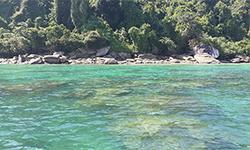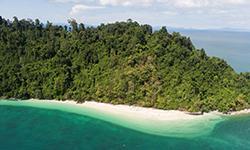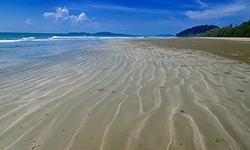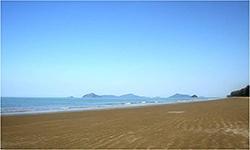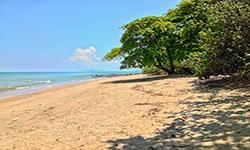Laem Son National Park
Contact Location : : Laem Son National Park, 36/6, Moo 4, Muang Kluang Sub-district, Kapoe District, Ranong Province, 85120
Telephone Number : (+66) 7 786 1431
Email : laemson_np@hotmail.com
Facebook : Laem Son National Park
Information
Laem Son National Park is located in Mueang, Kapur and Suk Samran District, Ranong Province, and Kuraburi District, Phang-Nga Province. It is a marine national park that covers the area of Laem Son Beach and nearby islands. The sylvan landscape consists of natural pine forest and a white sand beach, which is also a habitat for various birds. The terrific scenery covers approximately 196,875 rai, or 315 square kilometers.
Background
In 1980, Surat Thani Regional Forestry received a report from the Forestry Officer of the Forest Control Unit at Ro No.1 that the condition of the forest around Laem Son in Ratchakrut Sub-district, Mueang District, Ranong Province, was fertile with beautiful beaches and abundant aquatic animals. Therefore, the Surat Thani Regional Forest created order 154/2523, dated March 14, 1980, for Mr. Narong Chantrangkun, Forest Officer 4, to survey the area and establish a forest park.
According to the survey result, Laem Son Forest area is beautiful and suitable to be designated as a Forest Park for tourism and recreational purposes, Surat Thani Forestry issued aletter Ko So 0708 (So Do)/3660, dated October 7, 1980, to the Royal Forest Department, which resulted in order 125/2524, dated January 28, 1981 by the National Park Division, for Mr. Mano Manoonsaran, Forest Officer 4, to establish Laem Son Forest Park Muang District, Ranong Province.
Subsequently, a letter was issued about Laem Son Forest Park logged as Ko So 0713 (Ho So)/11, dated May 10, 1982, reporting an additional survey was required and requesting that the beautiful nature of Laem Son Beach be a National Park due to the complete condition of the pine forest, savanna, and nearby islands. This project would receive great support from Mr. Porn Udompong, the Governor of Ranong province.
The National Park Division brought the matter to the National Park Board and it was approved on July 22, 1982, at meeting No. 2/2525, with the royal decree specifying the area in Laem Son Beach and nearby islands as Ratchakrut Sub-district, Mueang Ranong District, Muang Kluang, Kapoe, Bang Hin, Naka and Kam Phuan Sub-district, Kapoe District, Ranong Province, and Kura Sub-district, Kuraburi District, Phang-Nga Province. The park covers an area of 315 square kilometers. The announcement that the park would become Thailand’s 46th National Park was made in the Government Gazette, Volume 100, Part 135, dated August 19, 1983.
Note : After paying the entrance fee to the National Park, please carry the receipt for inspection.
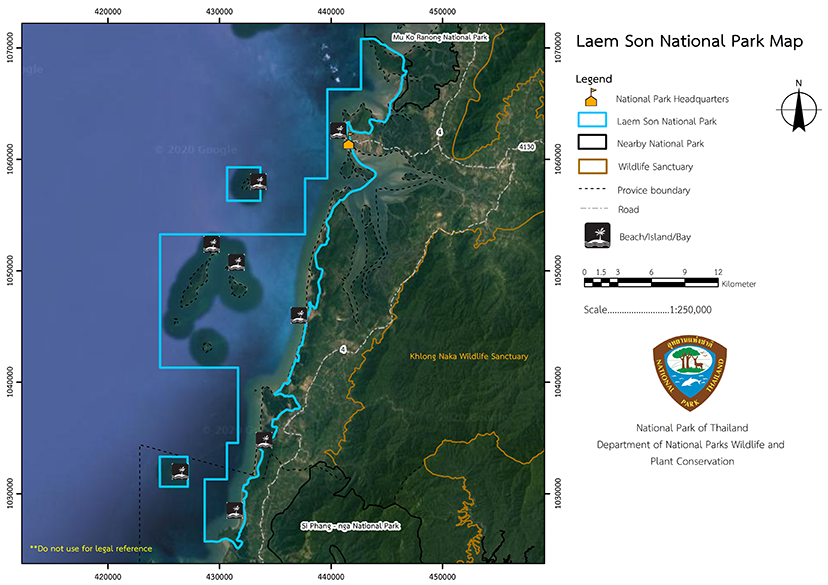
196,875 rai (315 square kilometers)
|
|
|
|
|
|
|
|
|
|
|
|
|
|
|
|
Nature trails ⇔ Observe flowers/plant ⇔ Bird/Butterfly ⇔ Viewpoint ⇔ Snorkeling ⇔ Camping
Welfare shop : shop (drinks, coffee, snacks): Open daily from 8.30 – 16.30 hrs.
National Park Headquarters : AIS, TRUE, DTAC
|
|
The Laem Son National Park is a sunken coast with narrow beaches along the shore. It is also home to waterways such as Lat Not Canal, Khanut Canal and Bang Ben Canal. These channels carry sediment deposits along the river estuaries to the coast, where they help form mangrove swamp forests.
|
|
Weather Laem Son National Park is located on the west coast of the southern region of Thailand, which is influenced by the southwest monsoon. These cause abundant rainfall throughout the year, but it is reduced in winter, when the northeast monsoon is in charge. . Temperature As the province is located in the peninsula location, it is fully affected by monsoons, which are southwestern monsoon from Indian Ocean and the northeastern monsoon from China Sea and the Gulf of Thailand. There are a lot of water vapor and it is very humid, so the average temperature is not that high. The average annual temperature is about 27.6 degrees Celsius. The yearly average lowest temperature is 34.8 degrees Celsius. The annual lowest average temperature is 22.5 degrees Celsius. The lowest temperature measured was 13.7 degrees Celsius. April is the hottest month with the highest recorded temperature of 39.6 degrees Celsius on March 31, 1983, and April 19, 1973. Relative Humidity The monsoons affect the relative humidity and air mass. Ranong Province has high levels of relative humidity throughout the year , with an average of 79.2% throughout the year. The seasons of Ranong Province can be divided into three seasons: Summer runs from mid-February to mid-May The weater is hot and April is the hottest month. However, as it is next to the sea, the wind and water vapor reduce the heat so it's not too hot. Rainy season starts in mid May and lasts till October. The northeastern monsoon hits Thailand with the low pressure trough moving to Thailand from time to time, thus a lot of rain in rainy season. August is the wettest month. Winter runs from mid October to February where the northeastern monsoon brings cold and dryness from China to Thailand. The temperature drops and the weather is cold. However, Ranong is next to the sea, the temperature drops slightly sometimes. The weather is not too cold, and there are a bit of rains along the coastlal line. |
|
|
|
In the beach area, visitors can find beach forest trees, which looks like a deciduous dipterocarp forest. It is home to plants such as Casuarina equisetifolia, Derris indica (Lamk.) Benn., Fish Poison Tree (Barringtonia asiatica (L.) Kurz), Gamari, Black Plum, Thespesia populnea (L.) Sol. ex Corrê, Terminalia catappa, Hibiscus tiliaceus, thorns, and Atalantia monophylla DC.. In the inland mountains are evergreen forests where plants found include rubber, Hopea pierrei Hance, Shores rogersiana, Wild Neem, and Calameae. Wildlife Due to the topography and abundance of plant communities, Laem Son National Park is a habitat for various animals. A mammalian survey in 1988 found many animals including the Common Treeshrew, Sunda Flying Lemur, Slow Loris, Southern Pig-Tailed Macaque, Crab-Eating Macaque, Southern Spectacled Leaf Monkey, Asian Palm Civet, Binturong, wild boars, Mouse Deer, Giant Pangolin, and Brush-Tailed Porcupine. A 1995 survey revealed 138 species consist of birds, consisting of 80 species of endemic birdsand 54 winter migratory species and 4 species that migrate during other seasons. The birds found include Pacific Reef Heron, Barhminy Kite, White-Bellied Sea Eagle, Red-Wattled Lapwing, Common Sandpiper, Sternidae, Spotted Dove, Collared Kingfisher, Wreathed Hornbill, Barn Swallow, Bulbul, Drongos, Black-Naped Oriole, Common Hill Myna. Reptiles found include Monitor Lizards, Butterfly Lizards, tortoises, and snakes. |
How to get there by car :
1. How to get there by private car from Bangkok takes about 8–9 hours on National Highway 4 (Phetkasem Road). Leave atthe Pathomphon (Chumphon) intersection, turning right through Kraburi District to Ranong town.
2. How to get there by buses are available from the Southern Bus Terminal, and there are standard buses, air-conditioned buses, and VIP buses available. For private bus tours, travelers can use the New Mitr Tour or Choke Anan Tour services.
Laem Son National Park Ranger Station Ho So No. 1 (Hat Praphat)
Laem Son National Park Ranger Station Ho So No. 2 (Khao Pak Triam)
Accommodation : Laem Son 101/1 (Kayu)
Laem Son 101/2 (Kayu)
Laem Son 102/1 (Kayi)
Laem Son 102/2 (Kayi)
Laem Son 103/1 (Dong Toei)
Laem Son 103/2 (Dong Toei)
Laem Son National Park offers lodging houses and camping grounds, including a tent and equipment rental service. The welfare shop is open during the high season.


